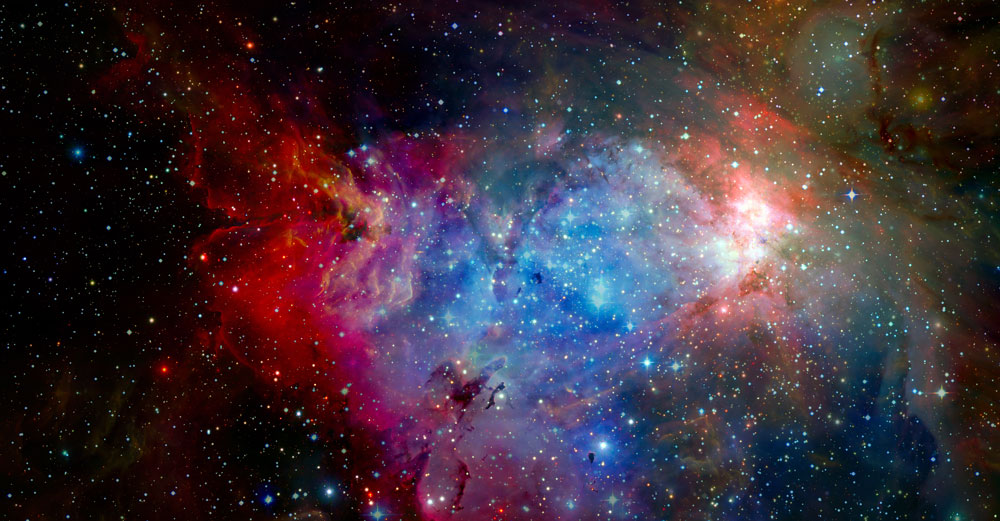
Digital Galaxies - How stars are born
Wouldn’t it be wonderful if we could – like in a science fiction movie – travel the universe to observe stars and planets from different angles? By creating galaxies in the computer, this is now possible!
The scientific method involves observations, hypothesis, experiments to test the hypothesis, and finally conclusions. In astrophysics, the time and length scales involved makes this procedure challenging. We can only passively observe the Universe and observations only give us two-dimensional projections of the three-dimensional Universe from a fixed vantage point, and are taken as snapshots in time.
Furthermore, the resolution is limited by our instruments because of the tremendous distances and the inability to move objects closer. While it would be amazing, we cannot build planets, stars, and much less galaxies in our laboratories, and therefore controlled experiments, the bedrock of most sciences, are out of reach for astrophysics.
For centuries, we have built new mathematical models to describe nature, and this has allowed us to obtain new insights into the workings of the heavens. An example of such success stories are stellar models: stars are enormous balls of gas, and the attractive force of gravity makes them approximately spherical.
This allowed astronomers to build the first precise models already a century ago by assuming spherical symmetry and solving the structural equations from the center of a star to the surface.
Like a spoon mixing milk in coffee
Today, the frontier in astrophysics is understanding how stars, gas, and dust interact in galaxies to create new stars, and how, around new-born stars, planets are formed. This is part of what is called the star-gas life cycle. In galaxies, gas is found in many different forms, from extremely hot and tenuous gas reaching 100 million degrees to cold and dense molecular clouds. The dynamics is driven by the differential rotation of the galaxies, that works like a spoon mixing milk in a coffee, and feedback from massive stars exploding as supernova and producing copious amounts of high energy radiation.
The end result is a complex, turbulent, filamentary gas structure. Stars are formed in the dense, cold regions: when the density is high enough, the attractive force of gravity wins over the constant changing turbulent flows, and a star is born.
Our basic model of gas flows are the equations of magnetized fluid dynamics. They describe how matter is transported under the forces from magnetic fields, gravity, and radiation. Fluid dynamics is non-linear, (ie.; the acceleration of a fluid depends on its speed), and in some fluids this non-linearity can be damped by friction (a prime example is honey that flows very slowly and steadily due to friction). However, in the Universe densities are very low, and friction is almost non-existent.
This combination of the non-linear nature of fluid dynamics, the low densities of the gas, and the enormous velocities imparted by exploding stars is what gives the interstellar gas its complex structure.
Molecular clouds give birth to stars
In astrophysics, computer simulations that solve the equations of fluid dynamics have emerged as an indispensable tool and substitute for carrying out laboratory experiments, to understand and interpret our observations. Simulations that solve the equations numerically are not only used to reproduce observations. Computational astrophysics is becoming the primary pillar of modern theoretical astrophysics because once we are able to reproduce observations, we investigate what are the most important forces at work, and that allow us to guide theory and test the validity of our models.
The Niels Bohr Institute has traditionally been at the forefront of computational astrophysics, and we have the last 40 years been developing new numerical codes and using the largest supercomputers world-wide to understand the Universe.
Today, we are developing a new unique tool, DISPATCH, which will make it possible to execute our models of up to a billion computer cores simultaneously, reaching so-called exa-scale levels of performance to show how stars are born in molecular clouds when dust and gas contract under their own gravity, and how they die explosively in supernovas.
Early users of new European supercomputer
To understand the life cycle of stars and gas in galaxies with a volume that contains enough material for tens of thousands of stars to be born has to be modelled, as massive stars are very rare. This requires enormous computational resources and algorithms that are capable to span a dynamical range of more than 100 million in space and time, i.e., from seconds to billions of years, from millimeters to lightyears.
Early next year a new European supercomputer, LUMI, will open and be in the top five of supercomputers world-wide. Researchers at NBI have been selected as one of a select few teams of early users. The combination of the new DISPATCH tool and the enormous power of the LUMI computer will make it possible to evolve a piece of the Milky Way in silicio over time scales of hundreds of millions of years allowing us to test our theories about the interaction between stars and matter in the Milky Way to better understand how stars are born and how galaxies evolve.
These models will be the most realistic ever of star-forming areas, and in close collaboration with astronomers from the Niels Bohr Institute, data will be compared with observations from the large European ALMA telescope.
